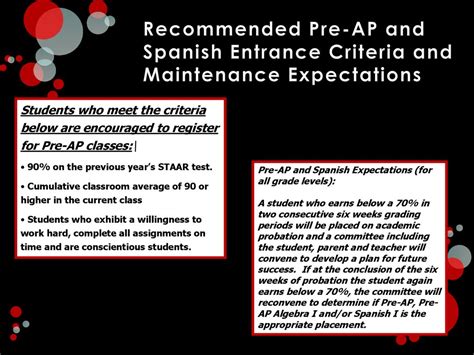Introduction: Embark on the Enchanting Journey of Spanish Fluency
As you embark on the exciting path of Pre-AP Spanish, it is essential to equip yourself with a clear understanding of the expectations and requirements that await you. This comprehensive guide delves into the depths of the Pre-AP Spanish curriculum, providing invaluable insights and practical tips to empower you to excel in this challenging yet rewarding endeavor.

Understanding the Course Objectives
Pre-AP Spanish is designed to bridge the gap between high school Spanish and college-level Spanish courses. It aims to foster a profound understanding of the Spanish language, its grammar, vocabulary, and cultural nuances. By the end of the course, students are expected to achieve the following objectives:
- Develop proficiency in all four language skills: listening, speaking, reading, and writing
- Enhance their knowledge of Spanish grammar and syntax
- Expand their vocabulary and deepen their understanding of Spanish idioms and expressions
- Explore the rich history, culture, and traditions of Spanish-speaking countries
- Prepare for the rigors of college-level Spanish courses
Curriculum Structure: A Roadmap to Fluency
The Pre-AP Spanish curriculum is meticulously structured to provide students with a comprehensive and engaging learning experience. The course typically consists of the following units:
- Unit 1: Intro to Spanish Culture
- Greetings, introductions, and basic conversation
- Spanish-speaking countries and cultures
- Unit 2: Present Tense
- Regular and irregular verbs
- Subject pronouns and verb conjugations
- Time expressions and calendar terms
- Unit 3: Past Tense
- Preterite and imperfect tenses
- Uses of ser and estar
- Actions and events in the past
- Unit 4: Future Tense
- Future tense formation
- Expressing intentions and plans
- Time expressions and future time frames
- Unit 5: Conditional Tense
- Conditional sentence structures
- Expressing possibilities and hypothetical situations
- Conditional clauses and their uses
- Unit 6: Command and Subjunctive Tenses
- Commands and requests
- Subjunctive tense formation
- Uses of the subjunctive mood
- Unit 7: Literary Texts
- Reading and analysis of short stories, poems, and other literary works
- Literary devices, themes, and cultural references
- Unit 8: Cultural Project
- Research and presentation on a topic related to Spanish-speaking culture
Expectations for Student Performance
To succeed in Pre-AP Spanish, students are expected to demonstrate a high level of commitment and dedication. Course expectations include:
- Regular Class Attendance: Students are required to attend all class sessions to maximize their learning opportunities.
- Active Class Participation: Active participation in class discussions, activities, and group work is essential for developing fluency and comprehension.
- Completion of Homework Assignments: Homework assignments reinforce concepts learned in class and provide additional practice opportunities.
- Preparation for Tests and Quizzes: Students are responsible for preparing for all tests and quizzes to assess their progress and identify areas for improvement.
- Independent Reading and Research: Outside reading and research help expand vocabulary, improve comprehension, and deepen cultural understanding.
- Cultural Immersion: Students are encouraged to immerse themselves in Spanish-speaking cultures through media, travel, and other experiences.
Grade Distribution: A Reflection of Effort and Progress
The student’s final grade in Pre-AP Spanish typically incorporates the following components:
- Class Participation (10%)
- Homework Assignments (20%)
- Quizzes (15%)
- Tests (40%)
- Cultural Project (15%)
Benefits of Pre-AP Spanish: A Gateway to College Success and Beyond
Embarking on Pre-AP Spanish offers a wealth of benefits for students, including:
- Enhanced Spanish Language Proficiency: Students develop a strong foundation in Spanish, preparing them for success in college-level Spanish courses.
- College-Level Exposure: Pre-AP Spanish provides a glimpse into college-level coursework, easing the transition to university studies.
- Improved Cultural Understanding: The course deepens students’ understanding of Spanish-speaking cultures, fostering intercultural appreciation and global awareness.
- Higher SAT and ACT Scores: Pre-AP Spanish courses have been shown to improve scores on standardized tests, such as the SAT and ACT.
- Increased College Readiness: Pre-AP Spanish students are better prepared for the academic rigors and expectations of college, both linguistically and academically.
Tips for Success: A Path to Language Mastery
To maximize your success in Pre-AP Spanish, consider the following tips:
- Attend Class Regularly: Make every effort to attend all class sessions to absorb the material and participate actively.
- Review Daily: Regularly review your notes and complete practice exercises to reinforce learning.
- Immerse Yourself in Spanish: Surround yourself with Spanish language and culture by reading books, watching movies, and listening to music in Spanish.
- Seek Help When Needed: Do not hesitate to ask questions in class or schedule appointments with your teacher for additional support.
- Set Realistic Goals: Break down large assignments into smaller, manageable steps to avoid feeling overwhelmed.
- Find a Study Buddy: Collaborate with classmates to practice conversations, compare notes, and quiz each other.
- Take Advantage of Resources: Utilize online resources, such as language-learning apps and websites, to supplement your learning.
Frequently Asked Questions (FAQs): Addressing Common Concerns
1. What level of Spanish proficiency is required to take Pre-AP Spanish?
Most Pre-AP Spanish courses are designed for students who have completed two to three years of high school Spanish.
2. How difficult is Pre-AP Spanish compared to other high school Spanish courses?
Pre-AP Spanish is generally more challenging than regular high school Spanish courses due to its accelerated pace and rigorous curriculum.
3. Will taking Pre-AP Spanish exempt me from taking Spanish in college?
In some cases, yes. Many colleges and universities offer placement exams that allow students to test out of introductory Spanish courses if they have taken and performed well in Pre-
